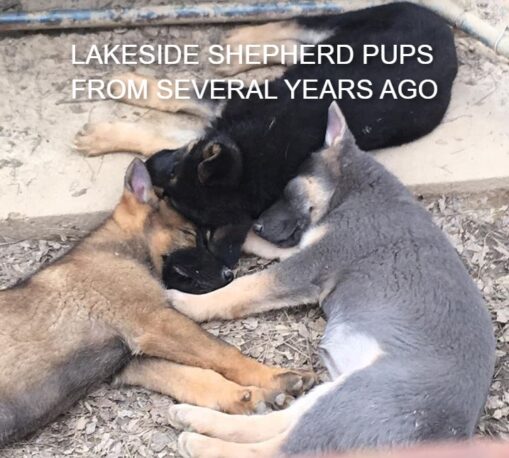Note: THIS WEBSITE PAGE IS UPDATED DAILY IN REGARD TO AVAILABLE GSDs. Pictures are updated occasionally.
LAKESIDE SHEPHERDS IS A GERMAN SHEPHERD BREEDING FACILITY. WE ARE NOT PHOTOGRAPHERS AND WE ONLY PROVIDE PICTURES TO SHOW THE COLOR. Our cell service is weak here so texting pictures is very difficult and videos are impossible to send. If you want a better view, feel free to make an appointment to see what one looks like up close.

WE HAVE MORE BLUE PUPS NOW @ $1275.00
SEE PICTURE BELOW

1 POWDER BLUE AKC MALE $1275.00
1 POWDER BLUE AKC FEMALE $1275.00
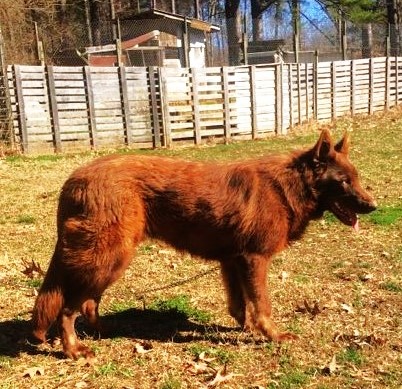
SEE PICTURES BELOW!
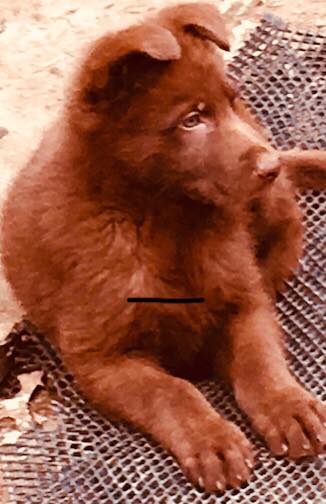
1 RED LIVER AKC MALE $1475.00
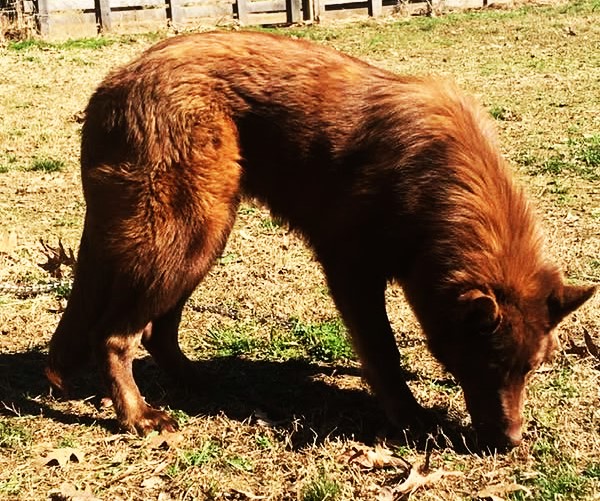
1 RED LIVER AKC FEMALE $1975.00
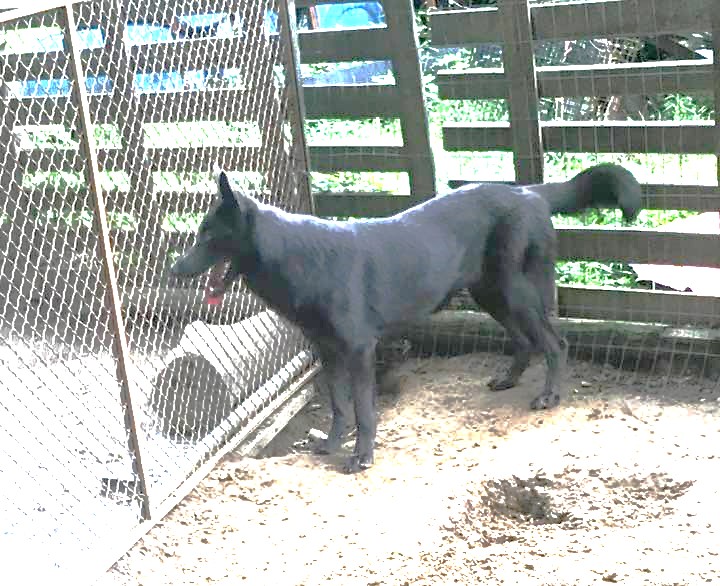
2 YR. OLD – NOT FOR SALE
ADDED TO OUR BREEDING PROGRAM

WE WILL HAVE SABLE PUPS IN A FEW MONTHS STARTING @ $775.00
MANY OF OUR SILVER SABLES ARE COLORED UP LIKE ARCTIC WOLVES. SEE PICTURE BELOW OF ARCTIC WOLVES.

WHILE SOME ARCTIC WOLVES ARE SOLID WHITE, MANY HAVE DARK COLORING DOWN THEIR BACK & SIDES SIMILAR TO OUR SILVER SABLE GERMAN SHEPHERDS.
* PREMISES PROTECTED BY A D T COMMERCIAL SECURITY SYSTEMS *
NOTE: THIS WEBSITE PAGE IS UPDATED DAILY.
PUPS SHOWN BY APPOINTMENT ONLY
Visitors are welcome after the pups are eating solid food and old enough to have their first vaccination. This is usually at 6 to 8 weeks of age.
Dogs can catch Covid-19 so no direct personal contact until you decide to purchase. This is for your protection as well as theirs.
Contact Information
Lakeside Shepherds – TEXT 731-549-0205 –EMAIL [email protected] Address – 411 Redbud Lake Road – Lexington, Tennessee 38351
Days of Operation – Monday through Saturday – Closed Sunday ***** TEXT FOR AN APPOINTMENT
The GSDs pictured above are currently available at LAKESIDE SHEPHERDS in Lexington TN. TEXT 731-549-0205 FOR AN APPOINTMENT TO SEE ONE OF THEM.
Lakeside Shepherds is dedicated to raising old style, straight back, medium drive, plush coat German Shepherds from working bloodlines for companions, therapy, personal guard and security service. Many of our pups have been used as service dogs for the disabled. All of our breeders have been registered with AKC and are from working class bloodlines; the same bloodlines used by the Military, Law Enforcement and Security Services.
Our pups are raised from Parents and Grandparents that have no history of hip or elbow problems. SEE RESEARCH ON HIP DISPLASIA BELOW.
Our Breeding Stock has been DM Health Tested and pups born from 2/1/2021 forward are guaranteed to be free of the DM Markers that would put them at high risk for having this disease. SEE BELOW FOR DISCRIPTION OF DM – DEGENERATIVE MYELOPATHY. Our Breeding Stock and their pups are also MDR1 clear.
All pups are guaranteed to be healthy, in every way, at the time of delivery. Extended guarantees are available for an additional fee. If the customer would like a pup to be tested for anything, we will be happy to do so at the customer’s expense. Pups will be up to date on puppy vaccinations and parasite control at the time of delivery.
TRAINING – We offer training, on Lakeside Shepherds pups, for a fee. Basic Obedience Training is a minimum of $395.00 and other training is also available as our schedule permits.
DEPOSITS – Pups that are READY TO GO can be held, without a deposit, for up to 24 hours giving the customer time to get to our location. To reserve or hold a pup longer than 24 hours or to get on our waiting list for a pup from a future litter requires a $200.00 deposit but please do not send a deposit or payment unless you are serious about wanting a pup because deposits and payments are not refundable.
FOR DEPOSITS, WE ACCEPT $200.00 U.S. POSTAL MONEY ORDERS (THAT CAN ONLY BE PURCHASED AT ANY U.S. POST OFFICE) MADE OUT TO AND MAILED TO DAVID AUTRY, 411 REDBUD LAKE ROAD, LEXINGTON TN 38351. JUST BEFORE MAILING THE DEPOSIT, BE SURE TO TEXT A PICTURE OF IT TO 731-549-0205 SO WE KNOW TO RESERVE THE PUP FOR YOU. ALSO PLEASE INCLUDE YOUR PHONE NUMBER PLUS THE SEX AND COLOR OF THE PUP YOU PREFER ON THE MEMO LINE OF THE MONEY ORDER. Your stub, from your Post Office Money Order, will serve as your receipt for your deposit. You can pay the balance due in CASH when you arrive to pick up your pup. We are not set up to accept Checks or Credit Cards.
When you purchase one of our pups, please be prepared to also purchase a large bag of food (50 pounds) from us at a cost of $50.00 because one of the worst things you can do is change your pup’s diet in the midst of changing everything else the pup is use to. No pup leaves our facility without a bag of food. Also, if you want AKC Registration Papers on your pup plus a five generation AKC Pedigree that’s $25.00 which is half price of what AKC charges just for the pedigree.
Discounts are sometimes available on some of our older pups for the Disabled or Veterans.
We know life can get hectic sometimes and if you’re concerned about something hindering you from picking up your pup when he’s ready to go, we will work with you if that happens and will feed and board your pup for $8.00 per day. That’s less than a third of the going rate to board a pet. If you need to reschedule an appointment for picking up your pup, please give at least 24 hours notice.
Personal Delivery is also available for a fee of at least 35 cents per mile round trip. Minimum Delivery Fee – $100.00 Delivered pups have to be paid in full prior to delivery.
For additional information, text 731-549-0205.
LAKESIDE SHEPHERDS PRODUCES MANY DIFFERENT COLORED GERMAN SHEPHERDS.

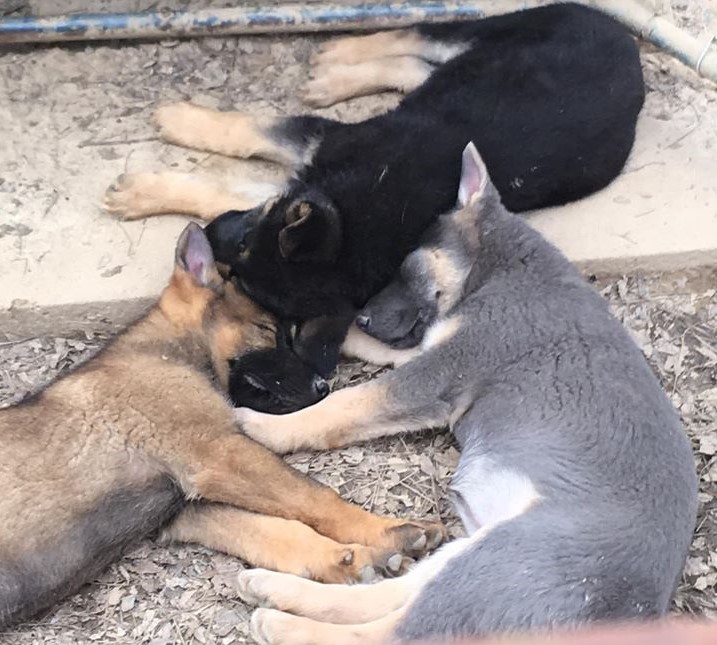
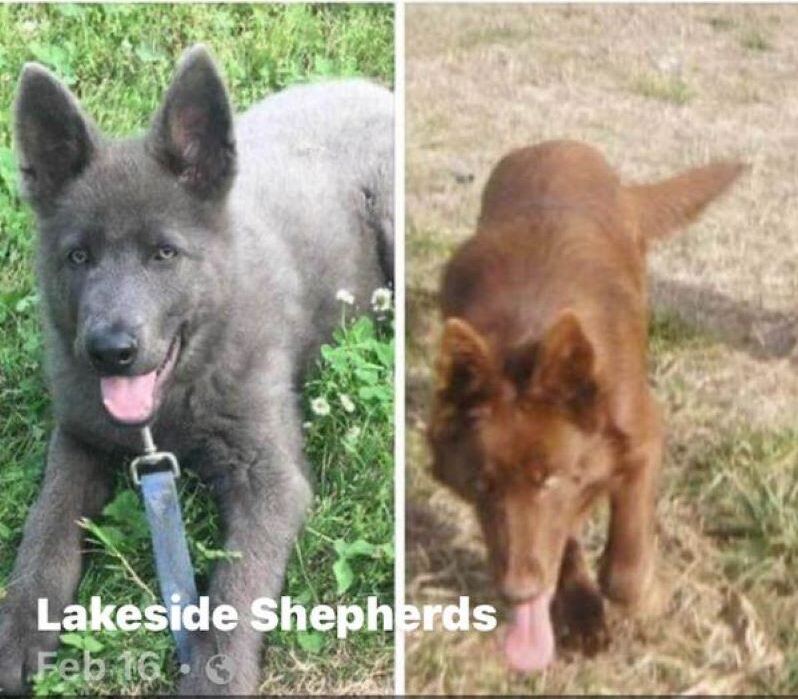
Lakeside Shepherds has some of the most unique German Shepherds that not only conform to Breed Standards but also offers a broad selection of colors.
Like Max Von Stephanitz, GSD breed founder, said: “No good dog is a bad color.”
Max’s vision was of a well built, mentally sound, family companion. While the breed was created to be a farm hand (herding dog) it also has the expectations of being the ultimate family/farm hand with patience, love and understanding of keeping the other farm animals safe and playing with the children. Max’s original book “German Shepherd in Word and Picture” has many photo’s of GSD playing with children, sharing their food with baby chicks, playing ring around a posy with the children, hanging out with baby lambs; basically the farmers right hand as they also kept the children safe and the farm animals safe from predators. They take their job seriously and love with their whole hearts. They want and need to be part of the family.
We have a 98% customer satisfaction rate.
One percent of our customers are not completely satisfied and have a legitimate reason which we make right.
The other one percent of our customers could not be satisfied by any breeder and are just looking for something for nothing or have unreal expectations.
Our happy customers are what helps our GSDs find new homes all over the UNITED STATES. and several FOREIGN COUNTRIES.

As you can see by the map, we have satisfied customers all over the United States (shown in yellow) 47 STATES plus DC and 11 FOREIGN COUNTRIES including the Philippines, Malaysia, Ecuador, Afghanistan, Canada, Guatemala, Brazil, Romania, Belize, Russia and Mexico as of 8/1/2023.
PUPS SHOWN BY APPOINTMENT ONLY
This is something everyone should see.
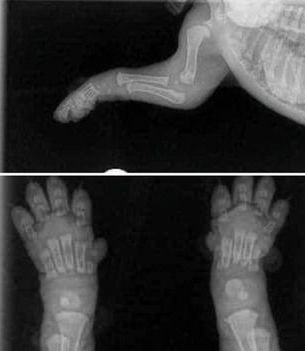
When you get your pup, please keep this image in mind. Their bones do not even touch yet. They plod around so cutely with big floppy paws and wobbly movement because their joints are entirely made up of muscle, tendons, ligaments with skin covering. Nothing is fitting tightly together or has a true socket yet.
When you run them excessively or don’t restrict their exercise to stop them from overdoing it during this period, you don’t give them a chance to grow properly. Every big jump or excited bouncing run causes impacts between the bones. In reasonable amounts, this is not problematic and is the normal wear and tear that every animal will engage in.
But when you’re letting the puppy jump up and down off the lounge or bed, take them for long walks/hikes, you are damaging that forming joint. When you let the puppy scramble on tile with no traction you are damaging the joint.
You only get the chance to grow them once. A well built body is something that comes from excellent breeding and a great upbringing-BOTH, not just one.
Once grown you will have the rest of their life to spend playing and engaging in higher impact exercise. So keep it calm while they’re still young and give the gift that can only be given once.
HIP DISPLASIA

MANY BREEDERS X-RAY THEIR SIRES AND DAMS IN AN ATTEMPT TO CONVIENCE THEIR CUSTOMERS THAT THE PUPS THEY ARE PRODUCING ARE SAFE FROM HIP DISPLASIA. NOTHING COULD BE FURTHER FROM THE TRUTH!
Research shows that as little as 15% of hip dysplasia is inherited and up to 85% is caused by environmental factors. Decades of selective breeding has made very little impact on the problem.
See the research posted below or click on the link to read the complete study.
The Institute of Canine Biology
The 10 most important things to know about canine hip dysplasia
3) Environmental factors are also important
Although there is a genetic influence on hip dysplasia, the heritability of the trait is rather low. Many studies have shown that genetic variation accounts for only a modest fraction of the variation in hip scores, usually 15-40%. This means that some fraction of the variation in the quality of the hips is the result of non-genetic, or “environmental” influences. This is one reason why decades of strong selection has resulted in only modest reductions in hip dysplasia in some breeds. At the current rate of progress and selecting only by phenotype, it could take decades to achieve a meaningful reduction in the incidence of hip dysplasia (Lewis et al 2013). The top three environmental factors that have been found to play a significant role in the develop of dysplastic hips are: a) joint laxity, b) weight, and c) exercise.
10) We can dramatically reduce hip dysplasia now
Genetic selection should continue to produce modest progress in the reduction of hip dysplasia. But a significant and immediate reduction in the number of afflicted animals could be achieved by better control of non-genetic, environmental factors. Weight management, appropriate exercise, proper nutrition, and early intervention at the first sign of lameness are simple steps we can take that will dramatically reduce the pain and suffering caused by hip dysplasia. The research will surely continue, but we already have the information we need to tackle this problem.
DEGENERATIVE MYELOPATHY
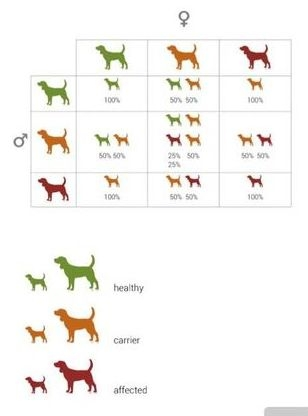
Breeding Carriers and Keeping the Gene Pool Stable
Breeding Carriers – DNA Testing in Breeding Program – AnimaLabs©
The only way to be sure of your dog’s genetic heritage is DNA testing. Responsible breeders are aware of the importance of such tests and get their dogs tested in order to maintain or improve the quality of their dogs. On the other side, often when the results show that their dog is a carrier for certain autosomal recessive disorder, owners appear confused or disappointed. Considering centuries of inbreeding among pure breed dogs, the appearance of carriers is not unusual. Additionally, some breeders appear discouraged from using their carrier dogs in the breeding program. Although the dog carries one copy of the causative mutation, other copy of the allele is healthy, and the carrier dogs will be completely healthy dogs considering a specific disorder. When breeding carrier with a clear dog, there is 50% chance that puppies will be clear and 50% chance that puppies will be carriers, but ALL PUPPIES WILL BE HEALTHY. On the other side, excluding carrier completely from the breeding program will reduce the gene pool for this dog’s genetic material. Carrying out this practice throughout years would cause dramatic shrinkage in the gene pool, which in turn, can lead to appearing of some new, until now unknown or extremely rare disorders.
Degenerative Myelopathy – A Brief Description
Degenerative myelopathy (DM) is a fatal, chronic, progressive, degenerative disease of the spinal cord of several breeds of dog, including the German Shepherd dog (GSD). There is no treatment for this disease and in time it leads to complete paralysis in all limbs (tetraparesis). Euthanasia is usually opted for before the disease progresses to this stage.
In DM there is a slow, progressive degeneration of an outer layer of tissue of the spinal cord (the white matter) in the thoracic (chest) section of the spine with loss of myelin and axons (Shell 2008). This degeneration appears to be due to the presence of excessive amounts of damaging reactive oxygen species molecules (ROS): biochemicals that react with and damage the components of cells, causing oxidative or free radical injury. High numbers of ROS occur with this condition, due to a mutation in the gene which codes for the production of the superoxide dismutase-1 (SOD1) enzyme, which is produced by cells to help break down ROS and limit any damage they might cause (Awano et al 2009).
The first signs of DM are classically seen at around 8 to 9 years of age and involve hindlimb ataxia (swaying when moving). As the disease progresses, hindlimb weakness occurs, leading to an inability to stand and then complete hindlimb paralysis. Most owners elect for euthanasia, once significant paralysis or paraplegia has occurred; however, if allowed to progress, the disease will ascend up the spinal cord to affect the forelegs leading to tetraplegia (inability to use all four limbs) (Awano et al 2009).
There is currently no effective treatment for this disease or its effects, though physiotherapy can help some dogs stay mobile for longer.

Puppy Socialization is NOT just about playing with other dogs and meeting other people.

In fact, too much uncontrolled exposure to other dogs can cause so many unintended consequences.
If you have a puppy, make sure you try to work on ALL aspects of socialization, as listed in the graphic.
Also, it’s a fine line between socialization and protecting your pup from exposure to disease. The pups first vaccination provides little protection to the pup due to the immunity passed down through the mother’s first milk. It tries to fight off the vaccine. Until a pup is past two weeks from the third vaccination, the pup is still at risk for picking up the diseases it was vaccinated for.
The first 16 weeks of age is the most critical time for socialization and preventing disease.
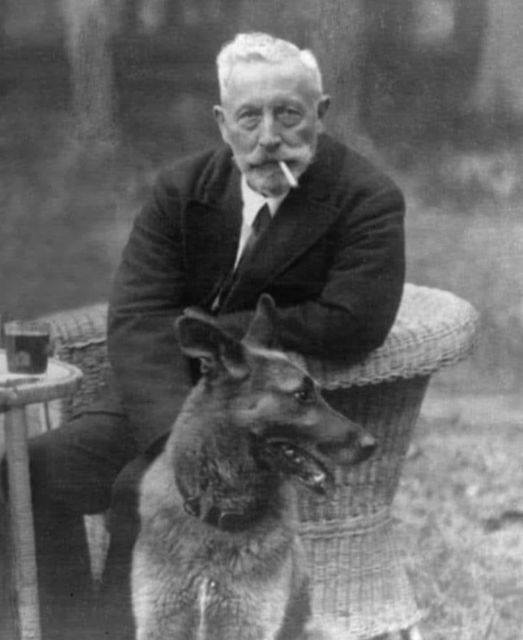
This photograph is of Max von Stephanitz, the first breeder of the modern German Shepherd dog breed, seen here sitting with one of the iconic dogs. Max von Stephanitz (1864–1936) was a German cavalry officer and dog breeder who is credited with standardizing the German Shepherd breed, which went on to become one of the most popular and versatile dog breeds in the world.
Historical Context:
1. Max von Stephanitz (1864-1936):
![]() Born on December 30, 1864, Max von Stephanitz was a German dog breeder and military officer. His significant contribution to the world of dog breeding came from his desire to create the ideal working dog.
Born on December 30, 1864, Max von Stephanitz was a German dog breeder and military officer. His significant contribution to the world of dog breeding came from his desire to create the ideal working dog.
![]() He began his career as a cavalry officer in the German military, which influenced his deep interest in working dogs, particularly those used for herding and guarding livestock. After retiring from the military, he dedicated his life to developing a dog breed that could serve multiple working roles, especially for herding but also for police and military use.
He began his career as a cavalry officer in the German military, which influenced his deep interest in working dogs, particularly those used for herding and guarding livestock. After retiring from the military, he dedicated his life to developing a dog breed that could serve multiple working roles, especially for herding but also for police and military use.
2. Development of the German Shepherd:
![]() In 1899, Max von Stephanitz attended a dog show where he saw a dog named Hektor Linksrhein, which he believed embodied all the qualities of the ideal working dog. Von Stephanitz purchased Hektor and renamed him Horand von Grafrath, declaring him the first registered German Shepherd dog.
In 1899, Max von Stephanitz attended a dog show where he saw a dog named Hektor Linksrhein, which he believed embodied all the qualities of the ideal working dog. Von Stephanitz purchased Hektor and renamed him Horand von Grafrath, declaring him the first registered German Shepherd dog.
![]() Horand became the foundation sire of the German Shepherd breed, and von Stephanitz established the Society for the German Shepherd Dog (Verein für Deutsche Schäferhunde, SV) to oversee the breed’s development.
Horand became the foundation sire of the German Shepherd breed, and von Stephanitz established the Society for the German Shepherd Dog (Verein für Deutsche Schäferhunde, SV) to oversee the breed’s development.
![]() Von Stephanitz was highly selective in breeding dogs that exhibited intelligence, strength, endurance, and versatility, prioritizing workability over mere appearance.
Von Stephanitz was highly selective in breeding dogs that exhibited intelligence, strength, endurance, and versatility, prioritizing workability over mere appearance.
3. German Shepherd’s Rise to Fame:
![]() Under von Stephanitz’s guidance, the German Shepherd quickly gained popularity as a working dog. By the early 20th century, German Shepherds were being used by the military and police for their intelligence, trainability, and loyalty.
Under von Stephanitz’s guidance, the German Shepherd quickly gained popularity as a working dog. By the early 20th century, German Shepherds were being used by the military and police for their intelligence, trainability, and loyalty.
![]() During World War I, German Shepherds were utilized for various purposes, including as messenger dogs, guard dogs, and search-and-rescue animals. Their abilities caught the attention of international audiences, and their popularity spread beyond Germany.
During World War I, German Shepherds were utilized for various purposes, including as messenger dogs, guard dogs, and search-and-rescue animals. Their abilities caught the attention of international audiences, and their popularity spread beyond Germany.
![]() In the post-war period, especially after World War II, the German Shepherd became a beloved companion, guard dog, and working dog around the world.
In the post-war period, especially after World War II, the German Shepherd became a beloved companion, guard dog, and working dog around the world.
4. Legacy:
![]() Max von Stephanitz’s work not only influenced the German Shepherd breed but also had a lasting impact on the standards for working dog breeds in general. His emphasis on breeding for performance and working ability over aesthetics became a guiding principle for future breeders.
Max von Stephanitz’s work not only influenced the German Shepherd breed but also had a lasting impact on the standards for working dog breeds in general. His emphasis on breeding for performance and working ability over aesthetics became a guiding principle for future breeders.
![]() Today, German Shepherds are one of the most widely recognized and respected breeds globally, used in police work, military service, search-and-rescue operations, and as loyal companions and family pets.
Today, German Shepherds are one of the most widely recognized and respected breeds globally, used in police work, military service, search-and-rescue operations, and as loyal companions and family pets.
Conclusion:
This photograph is a tribute to Max von Stephanitz’s legacy and his relationship with the German Shepherd breed. It symbolizes the close bond between the breed’s founder and the dog that went on to become one of the most celebrated working dogs in history. Von Stephanitz’s contributions revolutionized the breeding of working dogs, ensuring that the German Shepherd would be an enduring breed recognized for its intelligence, loyalty, and versatility.

The 1958 Sears winter catalog featured pets, including dogs and monkeys.
* PREMISES PROTECTED BY A D T COMMERCIAL SECURITY SYSTEMS *
Lakeside Shepherds is North America’s #1 Supplier of Old Style, Straight Back, AKC Registered German Shepherds.
Contact Information
Lakeside Shepherds – TEXT: 731-549-0205 EMAIL: [email protected]
Address: 411 Redbud Lake Road – Lexington, Tennessee 38351
Days of Operation Monday through Saturday – Closed Sunday ***** TEXT FOR AN APPOINTMENT
TEXT 731-549-0205 FOR AN APPOINTMENT
SEE MENU BELOW FOR MORE WEB PAGES ABOUT LAKESIDE SHEPHERDS.
